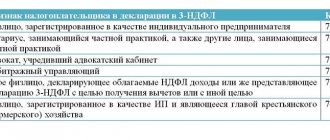Types of tax periods
According to paragraph 1 of Article of the Tax Code of the Russian Federation, the tax period is a period of time at the end of which the final tax base is determined and the final amount of tax is calculated, which must be transferred to the budget.
The specific tax period for each tax is established in Part 2 of the Tax Code (in the chapter devoted to the relevant tax). This period varies from a month to a year. The period of time at the end of which you need to calculate the total amount of the trading fee is called the taxation period, and the insurance premiums are called the settlement period.
Fill out, check and submit a new insurance premium calculation online for free
How is the tax period determined?
We have compiled data on the duration of periods for all taxes, as well as insurance premiums and trading fees, into a table.
| Length of period | Tax name | Article of the Tax Code of the Russian Federation |
| Month | Excise taxes | 192 |
| MET | 341 | |
| Gambling tax | 368 | |
| Quarter | VAT | 163 |
| Water tax | 333.11 | |
| UTII | 346.30 | |
| Trade fee | 414 | |
| Year | Personal income tax | 216 |
| Income tax | 285 | |
| Tax on additional income from hydrocarbon production | 333.53 | |
| Unified agricultural tax | 346.7 | |
| simplified tax system | 346.19 | |
| PSN (if the patent is issued for a shorter period, the tax period is the period for which the patent was issued) | 346.49 | |
| Transport tax | 360 | |
| Organizational property tax | 379 | |
| Land tax | 393 | |
| Property tax for individuals | 405 | |
| Insurance premiums | 423 |
Submit all tax returns online for free
Features of establishing the tax period
Tax periods have the principle of one-time tax payment. This means that the repayment of the tax liability in one tax period occurs once . For taxes that are one-time in nature, the concept of “tax period” is not used.
The procedure for adjusting the tax period, which is provided for by the Tax Code of the Russian Federation, cannot be called universal. For example, it cannot be used if the organization is located on UTII.
In some cases, the Tax Code provides for the abolition of reporting periods. However, this possibility is not provided for tax periods. This right is enshrined in law and applies to land tax (393 Tax Code of the Russian Federation).
Important! Two concepts such as the tax period and the deadline for tax payments should not be confused. If the first concept refers to the period of time for which the company summarizes the results of its commercial activities, then the second concept refers to the period of time during which the organization is obliged to pay the accrued tax. Both deadlines are regulated by the Tax Code.
The main feature of the tax period is that it is an important element of the entire taxation system, as well as an integral part of it. Without a tax period, it is impossible to determine the tax, as well as to include it in the fiscal scheme. The length of tax periods may change, but only in accordance with the Tax Code of the Russian Federation. This procedure is established for both federal and regional types of taxes. Even if the list of regional taxes is established by local authorities, they do not have the right to independently adjust the start and end times of the tax period (
What is the difference between tax and reporting periods
In accordance with paragraph 1 of Article of the Tax Code of the Russian Federation, a tax period may consist of one or more reporting periods. For example, it could be a month, two months, three months, etc., first quarter, second quarter, third quarter, half a year, 9 months. At the end of each reporting period, the taxpayer determines the interim base and contributes the amount of the advance payment to the budget.
As you can see, tax and reporting periods differ in the basis for calculating the amount that needs to be transferred at the end of the corresponding period of time. For the reporting period, this is a kind of “incomplete” base. It can be calculated based on actual data on income, expenses or payments for an intermediate period of time. Or it can be conditional, that is, determined based on data for previous periods or by calculation method. As for the tax period, the payment is always calculated based on the real financial result for the corresponding period of time.
REFERENCE
There may be situations where the final tax will be less than the advance payments made during the year. In this case, the taxpayer will have an overpayment, which can be returned or offset (Article of the Tax Code of the Russian Federation).
Submit an application for credit or refund of taxes (contributions) via the Internet Submit for free
Application of codes in practice
VAT reports are submitted to the tax office on forms approved by the Ministry of Finance. The importance of correct completion is due to the fact that errors lead to resubmission of the report. Their untimely identification is fraught with the risk of violation of the Tax Code and corresponding administrative measures.
To fill out the declaration, information is taken from the following databases:
- List of invoices from counterparties;
- Database for control of invoice forms;
- Book of sales and purchases;
- Information from tax and accounting reports.
The form consists of 12 pages, including the front page. It contains the following information:
- TIN/KPP;
- Document version. If it is submitted for the first time during the reporting period, then 0 is entered; if this is a clarification, then 1, 2 or another corresponding figure;
- Tax period code according to the above rules;
- Information about the company.
Section 1 contains the following points:
- OKTMO/KBK codes;
- The final tax amount is reflected in clauses 030, 040 and 050;
If in the current reporting period there were transactions for which VAT must be charged, then you should fill out paragraph 3. The following should be indicated here:
- The amount of tax according to the established rates;
- Amount of restored VAT;
- Deductions.
The value of the 1st point is formed as the sum of lines 200 and 210.
Sections 8 and 9 are filled out in accordance with data from the book of sales, purchases and other accounting documents.
Sections 4 and 6 are intended for companies engaged in exporting. All documents confirming the right to export and types of exported goods are taken into account here.
The finished report is submitted in electronic format. The title page and the first section must be completed. The remaining blocks are filled in depending on the type of transactions performed in the reporting period.
If an error is found in a document, a correction on the same form is unacceptable. To correctly display the information, a new report is drawn up - a corrective declaration.
VAT returns are completed manually. The option to fill out online has not yet been implemented. On the Federal Tax Service website there is only the possibility of sending. Before it, the entire document should be checked using the control ratios declared in the Letter of the Federal Tax Service of 20015.
Similar articles
- How to fill out sections of a VAT return without errors?
- VAT return for the 4th quarter of 2017
- Instructions for filling out a VAT return (example)
- VAT return for the 4th quarter of 2017
- Filling out the VAT return for the 3rd quarter
Codes for tax reporting periods in 2021
The amount of tax or advance payment that needs to be transferred to the budget is reflected in the tax return (if reporting is submitted for this tax or “advances”). The forms of the relevant declarations require a mandatory indication of the period for which the tax liability is calculated. In this case, information about the tax or reporting period is not written down in words, but is encoded as a number. This is necessary for machine processing of declarations.
Tax period codes for VAT
The following codes are used in the VAT declaration (Appendix No. 3 to the Procedure for filling out the declaration, approved by Order of the Federal Tax Service dated October 29, 2014 No. ММВ-7-3/ [email protected] ):
| 21 | I quarter |
| 22 | II quarter |
| 23 | III quarter |
| 24 | IV quarter |
| 51 | I quarter during reorganization (liquidation) of the organization |
| 54 | II quarter during reorganization (liquidation) of the organization |
| 55 | III quarter during reorganization (liquidation) of the organization |
| 56 | IV quarter during reorganization (liquidation) of the organization |
Also see “New VAT return form: how to submit reports for the first quarter quickly and without errors.”
Fill out, check and submit a new VAT return through Kontur.Extern Submit for free
VAT return tax period codes: 21, 22, 23, 24
The tax period in the VAT return is most often indicated by the numbers 21, 22, 23 and 24. They are entered in accordance with Appendix 3 to the order of the Federal Tax Service of Russia dated October 29, 2014 No. ММВ-7-3 / [email protected] , which is for tax periods 2019 -2020 applies as amended on November 20, 2019.
The numbers in the tax period code in the VAT return mean the following: the first digit of the code is a number that is always equal to 2, and the second digit varies depending on the quarter number. For example, 24 is the VAT return for the 4th quarter.
Similar codes are used in tax returns, the reporting periods for which are quarterly. In addition to VAT, such taxes, for example, include water (Article 333.11 of the Tax Code of the Russian Federation) or UTII (Article 346.30 of the Tax Code of the Russian Federation).
You will find a completed VAT return in ConsultantPlus. Try the system for free and proceed to the practical example and sample.
Codes of tax periods according to the simplified tax system
The following codes are used in the declaration under the simplified tax system (Appendix No. 1 to the Procedure for filling out the declaration, approved by order of the Federal Tax Service dated February 26, 2016 No. MMV-7-3 / [email protected] ):
| 34 | Calendar year |
| 50 | Last tax period upon reorganization (liquidation) of an organization or upon termination of activities as an individual entrepreneur |
| 95 | Last tax period when switching to a different taxation regime |
| 96 | Last tax period upon termination of business activity in general or upon termination of business activity in respect of which the taxpayer applied the simplified tax system |
Also see “From April 10, a new declaration form under the simplified tax system will come into effect.”
Submit a free notification of the transition to the simplified tax system and submit a declaration under the simplified tax system via the Internet
Encoding table
As we noted above, remembering the encodings for each form and type of fiscal declarations and other reporting is quite difficult. An error when filling out a form can be costly for a company. For example, an accountant will indicate an incorrect code in the report, therefore, tax authorities will not take into account the submitted information and will impose a fine for late provision of information.
To eliminate errors when filling out forms and forms in the Federal Tax Service, use a professional guide, which presents all the current encodings for the types of fiscal forms.
All tax period codes for declarations are in the table
Legal documents
- by order of the Federal Tax Service of Russia dated October 29, 2014 No. ММВ-7-3/ [email protected]
- Order of the Federal Tax Service of Russia dated October 19, 2016 No. ММВ-7-3/ [email protected]
Tax period codes for UTII
The UTII declaration uses the following codes (Appendix No. 1 to the Procedure for filling out the declaration, approved by order of the Federal Tax Service dated June 26, 2018 No. ММВ-7-3/ [email protected] ):
| 21 | 1st quarter |
| 22 | 2nd quarter |
| 23 | 3rd quarter |
| 24 | 4th quarter |
| 51 | 1st quarter during reorganization (liquidation) of the organization |
| 54 | 2nd quarter during reorganization (liquidation) of the organization |
| 55 | 3rd quarter during reorganization (liquidation) of the organization |
| 56 | 4th quarter during reorganization (liquidation) of the organization |
Also see: “A new form of UTII declaration has been approved.”
Connect to the service to fill out and send the UTII declaration in the current format
What form should I use to submit the report?
The VAT return form currently in use was approved by Order of the Federal Tax Service dated October 29, 2014 No. ММВ-7-3/ [email protected] as amended on December 20, 2016. You can download the form at the end of the article.
Please note that from the 1st quarter of 2021, changes will be made to the report form. This is due to the increase in the basic tax rate from 01/01/2019 from 18 to 20%. So, from this moment on, the report will need to be submitted using a new form. As soon as the legislator makes changes, we will definitely tell you about it.
Codes of tax periods for income tax
The following codes are used in the income tax return (Appendix No. 1 to the Procedure for filling out the declaration, approved by Order of the Federal Tax Service dated September 23, 2019 No. ММВ-7-3/ [email protected] ):
| 21 | first quarter |
| 31 | half year |
| 33 | nine month |
| 34 | year |
| 35 | one month |
| 36 | two month |
| 37 | three months |
| 38 | four months |
| 39 | five months |
| 40 | six months |
| 41 | seven months |
| 42 | eight months |
| 43 | nine month |
| 44 | ten months |
| 45 | eleven months |
| 46 | year |
| 50 | last tax period during reorganization (liquidation) of the organization |
Also see “Income tax return for 2021 must be submitted using a new form.”
Fill out and submit a current income tax return via the Internet Submit for free
How to determine the period value
According to the current rules for filling out payment orders, approved by the regulations of the Bank of Russia dated June 19, 2012 No. 383-P and clarified by order of the Ministry of Finance of the Russian Federation No. 107n, the decoding of tax period 107 is adopted as follows:
- “MS.XX.YYYY” is the designation of the fiscal payment that is transferred to the state budget for one calendar month, where “XX” is the digital designation of the month (from 01 to 12), and YYYY is the calendar year. For example, to credit the insurance premium for VNIM for August to the Federal Tax Service, in field 107 indicate “MS.08.2020”.
- “Q.XX.YYYY” is the quarterly payment of a tax, fee or contribution. In this meaning, “XX” is the digital designation of the quarter (from 01 to 04). For example, to transfer the quarterly VAT payment for the 2nd quarter of 2021, write in the field: “Q.02.2020.”
- “PL.XX.YYYY” - this value should be indicated in field 107 if the payment is transferred for the half-year. Instead of “XX” you must enter 01 or 02, depending on for which half of the year the fiscal fee is paid. Example: to pay the Unified Agricultural Tax for the 1st half of 2021, indicate “PL.01.2020” in the payment slip.
- “GD.00.YYYY” - if payment is made once a year. For example, if the final tranche of income tax for 2020 is transferred, then “GD.00.2020” is indicated in the payment slip.
IMPORTANT!
These values apply only to fiscal transfers, that is, to those payments that are credited directly to the Federal Tax Service. In other cases, the meaning of the code changes!
For example, how do you fill out tax period 107 to pay personal injury contributions? When transferring funds to the Social Insurance Fund, field 107 is entered as 0. But this condition only applies to contributions from accidents and occupational diseases. When paying insurance coverage to the Federal Tax Service (OPM, compulsory medical insurance or VNIM), you will have to indicate the codes given above.
Tax period 34
Code 34 in most cases corresponds to a tax period equal to a calendar year. For example, this is the code that is entered in declarations for the simplified tax system, personal income tax and corporate property tax.
When filling out income tax reporting, you need to take into account the following nuance. In the annual return, code 34 is indicated by those taxpayers who submit returns quarterly. If the organization reports profit monthly, then the final declaration contains the number 46, which also indicates the year.
When the tax period can be changed
In certain cases, the start and end dates of the tax period may be changed. We are talking about new newly created or closed companies. These also include companies that are in the process of reorganization. For companies being liquidated or undergoing a reorganization process, the tax period will begin on January 1 and end on the day the company closes. The end of activity is confirmed by the fact of state registration.
During reorganization, a new business entity is created. The tax period for this organization will begin not from January 1, but from the date of registration of the person with government agencies and tax registration. The last day of the tax period will not differ from other companies.
Separately, it is worth highlighting the procedure for determining the tax period for organizations that were registered in December and officially ceased their activities in the same month of the same year. For such companies, the tax period is equal to the operating period.
If the tax period is equal to a quarter, then for newly created entities it will be determined from the day the company is formed until the end of the quarter. If less than 10 days remain from the date of registration until the end of the quarter, then the remaining days of the current period are subject to addition to the next quarter.
In the event of termination of the activities of an organization or individual entrepreneur, the tax period changes as follows: the results are summed up in the period from the first day of the quarter to the date of registration of the fact of termination of the company's activities.
When the tax period is 1 month, new companies take into account the period of time from the moment they open their business to the last day of the month. Accordingly, when a company is closed, the tax period will be established from the first day of the accounting month until the date of actual termination of activity.
Important! The rules by which the time boundaries of tax periods are determined do not apply to taxes calculated in connection with the use of UTII or the patent tax system.
The start date of the tax period for foreign companies will depend on the date of submission of an application for tax resident status to the tax authority. If the notice indicates the start of work from January 1, the tax period is counted from this date. If the application is submitted in the middle of the year and it indicates that the start date of activity and the date of submission of documents coincide, the beginning of the period is calculated from the moment the notification is provided.
Codes for the reporting period of financial statements in 2020
In accounting, the reporting period is the period for which the organization must prepare financial statements (clause 4 of PBU 4/99). For annual financial statements, this period is the calendar year - from January 1 to December 31 inclusive. An exception applies to cases of creation, reorganization (except transformation) and liquidation of a legal entity (Clause 1, Article 15 of the Federal Law of December 6, 2011 No. 402-FZ “On Accounting”).
ATTENTION
In financial statements, data on periods is not coded, but is indicated by entering the date, month and year.
The form of the balance sheet (approved by order of the Ministry of Finance dated July 2, 2010 No. 66n) does not provide for coding the reporting period. Specific reporting dates are indicated on the title page and in the table with indicators, rather than period codes. In the same way, that is, without using codes, data on periods is filled out in the form of the Statement of Financial Results.
Also see “The balance sheet for 2021 will need to be submitted using a new form.”
Prepare, check and submit financial statements to the Federal Tax Service via the Internet Submit for free







